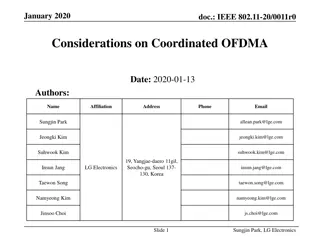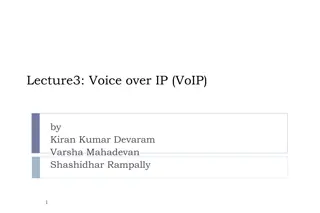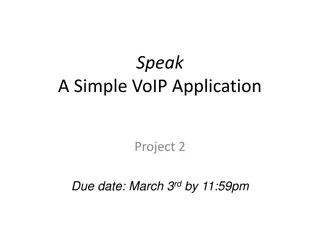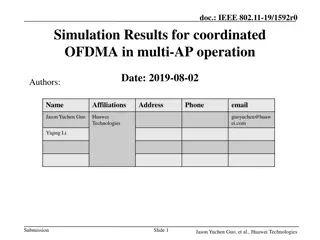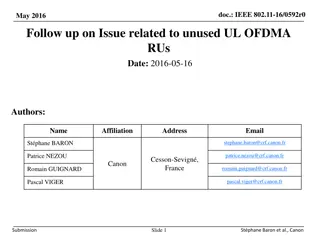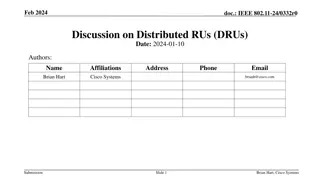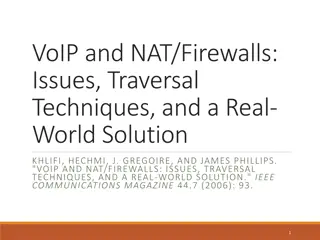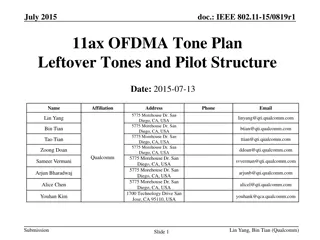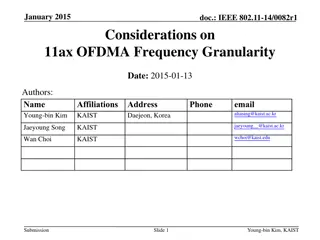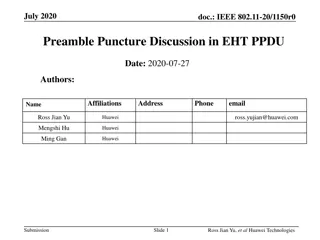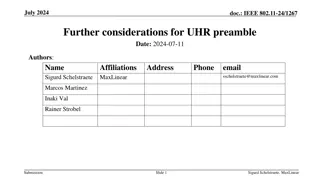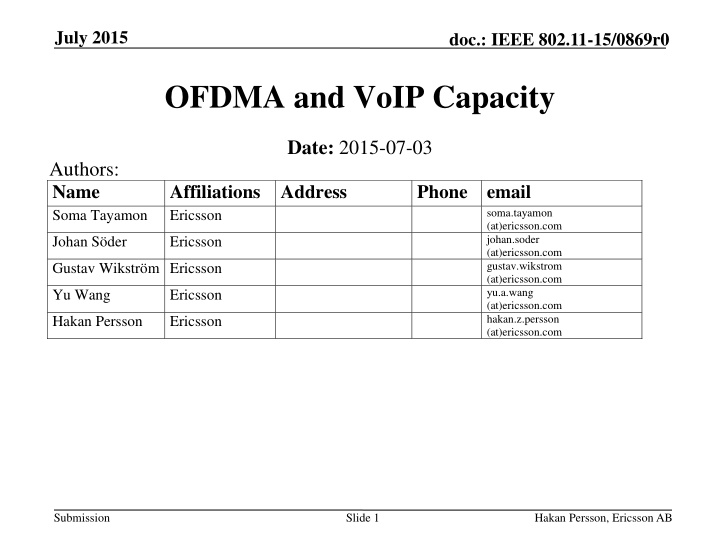
Investigating VoIP Capacity Improvement Using OFDMA in IEEE 802.11ax
Explore how the introduction of OFDMA in IEEE 802.11ax enhances VoIP capacity by reducing delay and packet loss. Discover the potential gains offered by OFDMA for small packet transmissions in VoIP traffic models. Learn about performance metrics, simulations, and user satisfaction evaluations in the context of VoIP over OFDMA technology.
Uploaded on | 1 Views
Download Presentation

Please find below an Image/Link to download the presentation.
The content on the website is provided AS IS for your information and personal use only. It may not be sold, licensed, or shared on other websites without obtaining consent from the author. If you encounter any issues during the download, it is possible that the publisher has removed the file from their server.
You are allowed to download the files provided on this website for personal or commercial use, subject to the condition that they are used lawfully. All files are the property of their respective owners.
The content on the website is provided AS IS for your information and personal use only. It may not be sold, licensed, or shared on other websites without obtaining consent from the author.
E N D
Presentation Transcript
July 2015 doc.: IEEE 802.11-15/0869r0 OFDMA and VoIP Capacity Date: 2015-07-03 Authors: Name Soma Tayamon Affiliations Address Ericsson Phone email soma.tayamon (at)ericsson.com johan.soder (at)ericsson.com gustav.wikstrom (at)ericsson.com yu.a.wang (at)ericsson.com hakan.z.persson (at)ericsson.com Johan S der Ericsson Gustav Wikstr m Ericsson Yu Wang Ericsson Hakan Persson Ericsson Submission Slide 1 Hakan Persson, Ericsson AB
July 2015 doc.: IEEE 802.11-15/0869r0 Abstract The capacity of VoIP by introducing OFDMA for 802.11ax has been investigated. The delay and packet loss for each user is the metrics evaluated. It is shown that the delay and loss are significantly reduced using OFDMA. At around 60 VoIP users/AP, the delay is reduced such that the desired value of maximum of 50 ms of delay is achieved. Using OFDMA yields less channel utilisation (30%) increasing the possibility for other uses of the channel. Submission Slide 2 Hakan Persson, Ericsson AB
July 2015 doc.: IEEE 802.11-15/0869r0 Background For small packets, OFDMA has shown great potential w.r.t user throughput, [1]. Since VoIP contains small packets, OFDMA may improve VoIP capacity. VoIP traffic model consists of periods of active talking (33 Bytes) with a period of 20ms and silence (7 Bytes) with a period of 160ms, [2]. Submission Slide 3 Hakan Persson, Ericsson AB
July 2015 doc.: IEEE 802.11-15/0869r0 Background (cont.) What is the potential gain using OFDMA? Small packet OH in each OFDM-symbol more users can be scheduled using OFDMA Calculation assumptions: 20 MHz BW and 802.11ax numerology 256 subcarriers (235 usable) and 26 subcarriers per user. Fixed MCS = 17 (173.3 Mb/s) 11ax cyclic prefix for indoor ??? [????] ???.? ???[????/?]= ?.?? ?? ?? for a VoIP packet. With an OFDM symbol duration of 13.6 s, 12.1 s are not used. Up to 8 users can be scheduled simultaneously using OFDMA. Submission Slide 4 Hakan Persson, Ericsson AB
July 2015 doc.: IEEE 802.11-15/0869r0 Performance Metrics User satisfaction is measured in terms of delay and packet loss. According to ITU, see [3], the delay (excluding decoding and encoding delay) should be below 50ms for satisfactory results. Packet loss could occur either due to collision, low channel quality or packets arriving later than 50ms. A user is being in outage if more than 2% of the packets are loss resulting in dissatisfied users. Submission Slide 5 Hakan Persson, Ericsson AB
July 2015 doc.: IEEE 802.11-15/0869r0 Simulations The simulations consist of: 1 AP and fixed no of VoIP users Each call lasts for 20 s. The following assumptions were used for all simulations: 20 MHz BW with ax-numerology 256 subcarriers (235 usable) and 26 subcarriers per OFDMA user, and indoor cyclic prefix Both UL and DL (OFDMA in DL) Adaptive auto-rate fallback link adaptation algorithm Analysis are performed for each user in the BSS where the mean delay and packet loss for each user is used for evaluation. Submission Slide 6 Hakan Persson, Ericsson AB
July 2015 doc.: IEEE 802.11-15/0869r0 Results Packet Delay The delay is reduced using OFDMA. For values below 60 users the delay is not dissatisfactory but for values up to 80, the mean delay is reduced to desirable values The 98th percentile of packet delay is reduced to ~70 users 600 400 OFDMA (mean) Non-OFDMA (mean) OFDMA (98th perc.) Non-OFDMA (98th perc.) OFDMA (mean) Non-OFDMA (mean) OFDMA (98th perc.) Non-OFDMA (98th perc.) 500 300 Packet delay [ms] Packet delay [ms] 400 300 200 200 100 100 0 0 30 40 50 Nr of VoIP users 60 70 80 90 65 70 75 80 85 Nr of VoIP users Submission Slide 7 Hakan Persson, Ericsson AB
July 2015 doc.: IEEE 802.11-15/0869r0 Result Packet loss No packet loss below 60 users The mean and 98th percentile of lost packets is significantly reduced using OFDMA 70 70 OFDMA (mean) Non-OFDMA (mean) OFDMA (98th perc.) Non-OFDMA (98th perc.) OFDMA (mean) Non-OFDMA (mean) OFDMA (98th perc.) Non-OFDMA (98th perc.) 60 60 50 50 Packet loss [%] Packet loss [%] 40 40 30 30 20 20 10 10 0 0 30 40 50 Nr of VoIP users 60 70 80 90 60 65 70 Nr of VoIP users 75 80 85 90 Submission Slide 8 Hakan Persson, Ericsson AB
July 2015 doc.: IEEE 802.11-15/0869r0 Results Utilisation No OFDMA: congestion at around 60 to 70 VoIP users OFDMA occupies less, at 60 users ~30% less is used and can be used by other media such as file download, video streaming etc. 100 90 Channel Usage [%] 80 70 60 50 OFDMA Non-OFDMA 40 30 30 40 50 Nr of VoIP users 60 70 80 90 Submission Slide 9 Hakan Persson, Ericsson AB
July 2015 doc.: IEEE 802.11-15/0869r0 Conclusion The impact of OFDMA on VoIP calls has been evaluated The results show that the packet delay and packet loss are decreased using OFDMA for high number of users The channel usage is decreased using OFDMA freeing up the channel for other users or APs to be used for e.g. file download and video streaming Submission Slide 10 Hakan Persson, Ericsson AB
July 2015 doc.: IEEE 802.11-15/0869r0 References [1] 11-15/0383r3, Impact of number of sub-channels in OFDMA . [2] 11-14/0875r0, VoIP Traffic Model Content for 11ax TG Simulation Scenarios and Evaluation Methodology [3] Report ITU-R M.2135-1, Guidelines for evaluation of radio interface technologies for IMT-Advanced . Submission Slide 11 Hakan Persson, Ericsson AB



